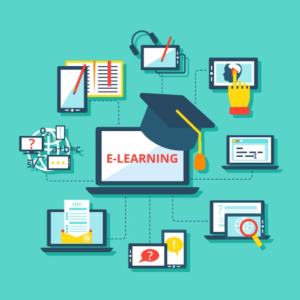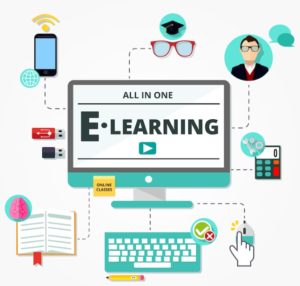Navigating E-learning Platforms: A Comprehensive Guide for Success
E-learning platforms: The COVID-19 pandemic caused a dramatic change in the educational environment, forcing the conventional school system to move online. Electronic Learning has recently become a popular and efficient method of imparting knowledge and skills, thanks to the proliferation of distance education and digital transformation.
Personalized online learning management systems have become vital resources for teachers and instructors in today’s classrooms. Careful preparation and execution are necessary to create an efficient e-learning platform. Here, we will explore nine crucial best practices for developing high-quality bespoke e-learning platforms. With these methods, the growth process might be faster and more useful. They also aim to get people more involved and improve their Learning.
1. Identify Who You’re Posting To
An in-depth familiarity with your intended audience is the first step in developing individualized e-learning programs that meet the requirements of your students. Important considerations in creating an intuitive platform include user demographics, education level, and preferred learning methods. Using personas, focus groups, and surveys can yield useful information that will guarantee your platform instantly connects with its target audience.
Further refining the design and functionality by acknowledging the devices and technologies utilized by your audience augments the platform’s attractiveness to the target market.
2. Establish Concrete Goals for Learning
Setting specific, attainable, and quantifiable goals for the learning process is crucial to the success of any online learning platform. These goals give students a clear picture of what they may expect to achieve after they finish the course and are in line with the overall aims of your bespoke e-learning solutions. To guarantee the effectiveness of the e-learning platform and enable objective evaluation, it must adhere to the SMART standards, which stand for Specific, Measurable, Attainable, Relevant, and Time-bound.
3. Verify Multimedia Compatibility
Incorporate multimedia components that supplement challenging ideas and aid in information retention to improve the learning experience. Multimedia components must be directly related to the course material and learning goals. When picking out multimedia elements for the platform, the goals can be better met with the help of specialized e-learning creation services.
4. Make Sure Your Platform Is Consistently Organized
The e-learning platform has a consistent framework that makes it easier for students to navigate. You can set your platform apart from the competition with a polished look and feel that includes features like an easy-to-navigate menu, a uniform lesson layout, and a sensible progression of lessons. Learners can feel more accomplished and see how far they’ve come with the help of completion tracking and progress markers.
5. Make Your Design Accessible

Embark on a learning journey with our guide to navigating e-learning platforms, ensuring success in the digital realm of education.
If you want your e-learning platform to be accessible to everyone, you should prioritize it. This includes ensuring the content is compatible with assistive technology and offering alternative formats like audio or text transcripts. Your platform’s accessibility will be enhanced, and your organization’s social responsibility will be showcased when you adhere to the Web Content Accessibility Guidelines (WCAG).
6. Create a Gamified Learning Environment
With its ability to inspire and engage students, gamification quickly becomes an indispensable component of tailored e-learning platforms. To ensure the e-learning platform is cohesive and effective, ensure the gamification aspects are aligned with the learning objectives.
7. Use Personalized Learning Support
Maximize engagement and motivation by embracing individualized learning experiences. Make it easy for students to monitor their progress and get specific comments by adapting course materials to their interests and providing multiple-choice and other forms of personalized assessment. To ensure that individualized aspects are used to fulfill the demands of individual learners, it is advisable to consult with seasoned bespoke e-learning development services.
8. Protect the Integrity and Secrecy of All Personal Data
Preserving the confidentiality and integrity of student information is critical to keeping faith. Set up stringent safety protocols, such as encrypted data, firewalls, and SSL certificates. Complying with data protection rules like CCPA and GDPR is crucial to fulfill legal obligations and preserve learners’ privacy.
9. Try, Adjust, and Try Again
It must undergo continuous testing and improvement to ensure the e-learning platform can adapt to learners’ changing needs and goals. Regular usability testing, A/B testing, and asking teachers and students for feedback make it possible to keep making changes. Specialized e-learning development companies can help make these tests easier. They can also give you tips on how to make the content more useful and effective over time.
Finally, careful preparation and execution are required to construct top-notch e-learning systems. By following the best practices, teachers may engage students and get great results from online courses.
Consider HURIX Digital’s Higher Education services if you’re considering building an excellent e-learning platform for your university. Our team of experts is dedicated to creating an e-learning platform specifically suited to your learners’ needs. We will work with you to achieve your learning objectives. Contact us today to find out how our services for higher education can revolutionize your online learning platform.
Frequently Asked Questions about E-Learning Platforms
This Frequently Asked Questions (FAQ) guide will help you better understand E-Learning Platforms. E-Learning Platforms are becoming more important in the educational environment because they provide learners with dynamic and adaptable learning experiences. Whether you’re an experienced teacher or just starting out, this guide will help you develop effective eLearning platforms, understand their aims, and achieve the level of effectiveness that today’s students require.
The first question is: what makes an eLearning platform work?
Strategic planning and implementation are essential for the creation of a successful eLearning platform. Important stages to construct one are as follows:
a. Figure Out: Who You’re Writing For Knowing who you’re writing for is vital. Get to know their likes, dislikes, and learning methods so you may modify the platform to suit them.
b. Be Specific: In line with the overarching goals of your eLearning platform, set clear, measurable learning objectives.
c. Enhance Engagement with Multimedia and Interactivity: Supplement the learning process with multimedia components and interactive features to increase engagement.
d. Make It Accessible: Make sure that people with impairments can utilize the platform easily. Make available alternate formats and follow accessibility guidelines.
e. Use Gamification and Personalization: Incorporate gamification features and personalized learning experiences to make Learning more engaging and tailored to user preferences.
f. Put Security First: Ensure strong security procedures are in place to protect user data and keep their trust. Data protection laws must be followed.
g. Keep Testing and Improving: Regularly check the platform’s usability and receive feedback to ensure it is current with learners’ changing demands.
E-Learning platforms are what?
Online learning environments, or e-learning platforms, are virtual meeting places for educators and students to share resources and engage in collaborative Learning. Users can learn quickly because of the abundant courses, modules, and materials hosted on these platforms.

Embark on a journey of success with our comprehensive guide to navigating E-learning platforms.
How can eLearning be effective?
Several elements impact the success of online Learning:
a. Participation and Interaction: Top eLearning systems provide an immersive learning environment by encouraging participation through interactive material.
b. Customization: eLearning is more effective when content is tailored to the needs of individual learners.
c. Accessibility: For the platform to truly foster diversity and reach a varied audience, it must be made available to them.
d. Incorporating Technology: Combining traditional classroom instruction with cutting-edge tools like gamification and multimedia improves students’ experience.
e. Ongoing Enhancement: The platform’s continued relevance and effectiveness are guaranteed by consistently updating and improving material in response to user feedback.
Why are eLearning systems created?
Online learning systems mainly aim to accomplish the following:
a. Adaptability and ease of access: letting students study at their speed and ensuring they have simple access to instructional materials.
b. Better Learning Outcomes: Improve education by aligning learning objectives with interactive and engaging content.
b. Efficient Use of Resources: Minimizing Expenditures on Conventional Learning Methods Like Travel and Written Materials.
d. Global Reach: Removing geographical barriers so that education can reach people worldwide.
e. Learning that lasts a lifetime: making it possible to keep learning and improving one’s abilities throughout one’s life.
What is the most important thing to keep in mind when studying online?
Being actively involved is the most important factor in achieving success in online Learning. Interesting information, engaging features, and an easy-to-navigate layout enhance an enjoyable learning experience.
How successful are online learning systems in the classroom?
There are various reasons why e-learning platforms have been so successful in the field of education:
a. Accessibility: Making instructional materials available to students whenever and wherever they need them.
b. Being adaptable means accommodating different learning methods and letting students go at their speed.
c. Interactivity: Encouraging participation through quizzes, discussions, and multimedia components.
d. Customization: meeting the unique requirements of each student by making the material more engaging and relevant.
a. Efficiency in Costs: Cutting back on expenses related to conventional schooling, like transportation and textbooks.
To sum up, eLearning platforms are essential to contemporary education because they provide a fresh and efficient method of education. These platforms enable learners and aid in excellent educational outcomes by emphasizing interaction, Customization, and ongoing improvement.



Post Comment